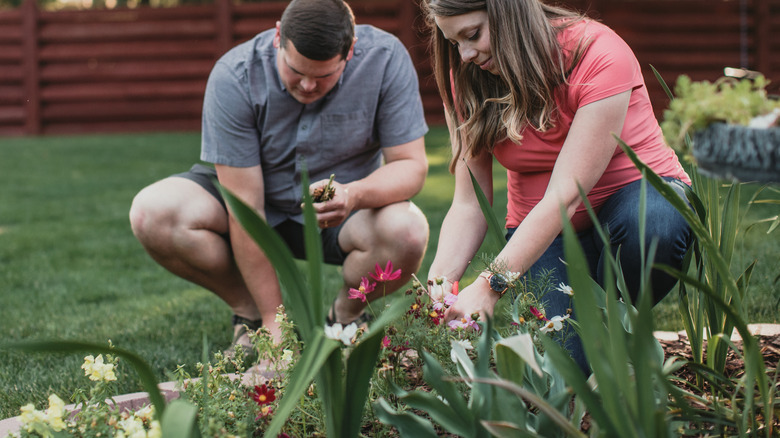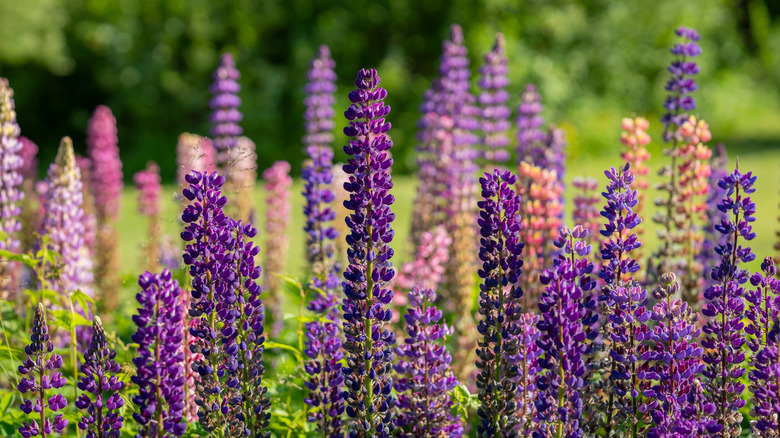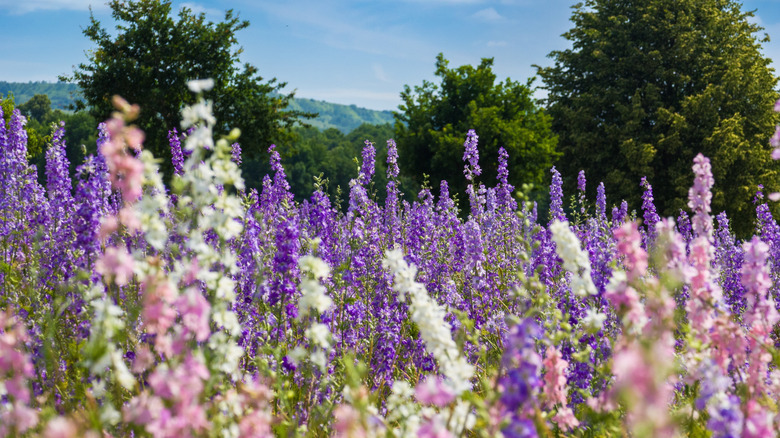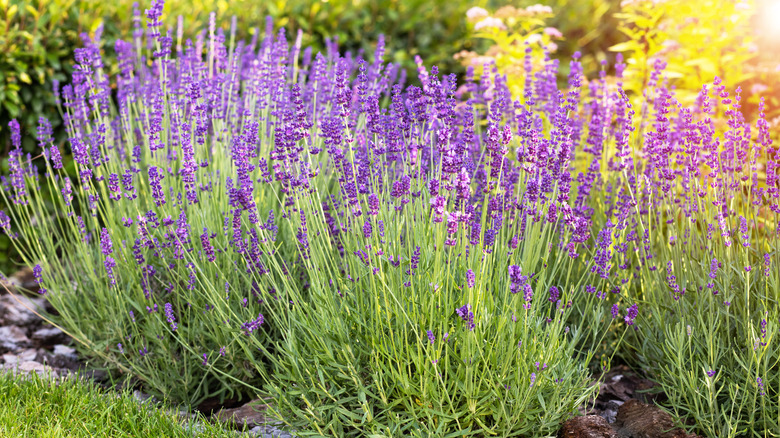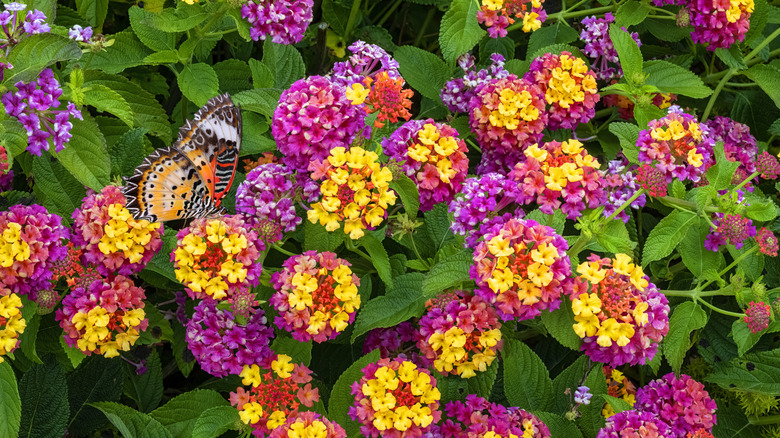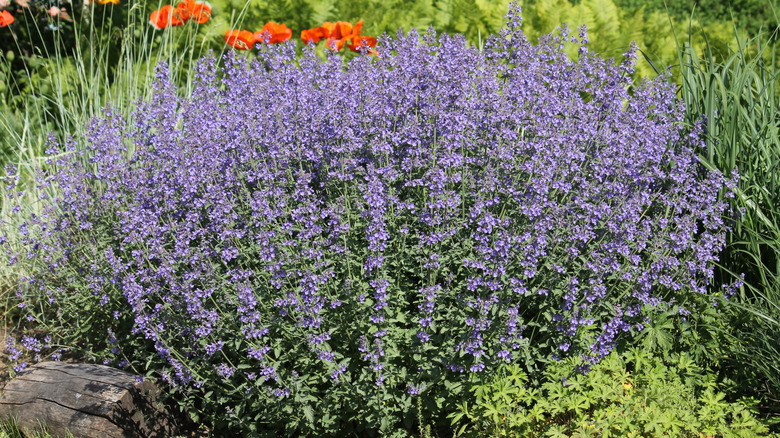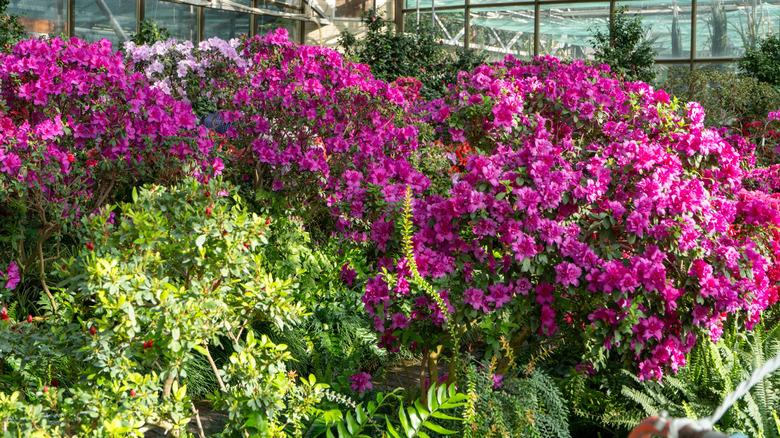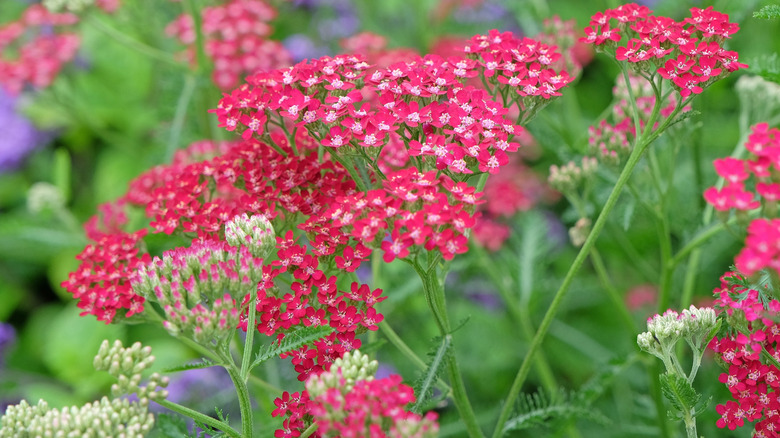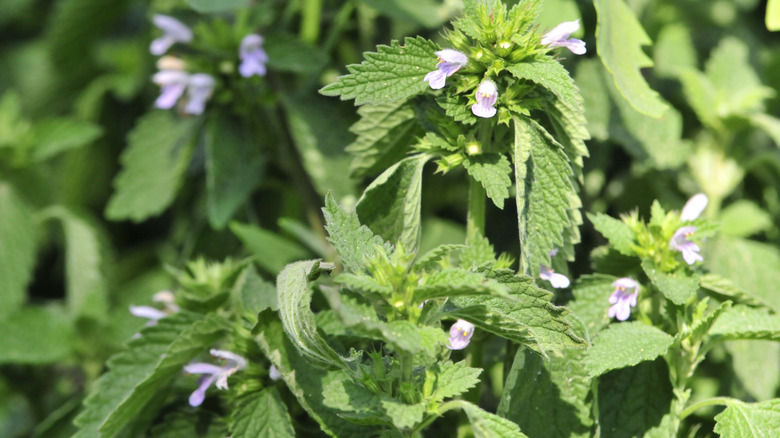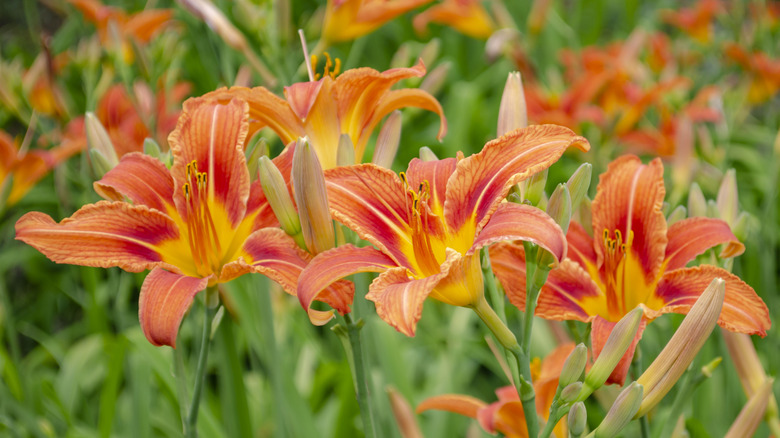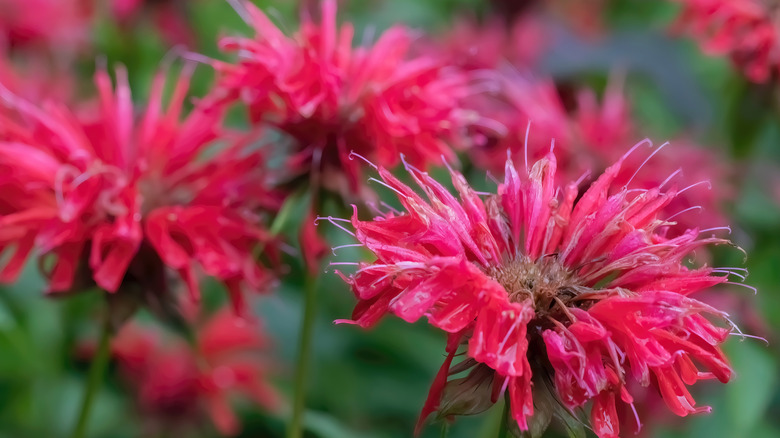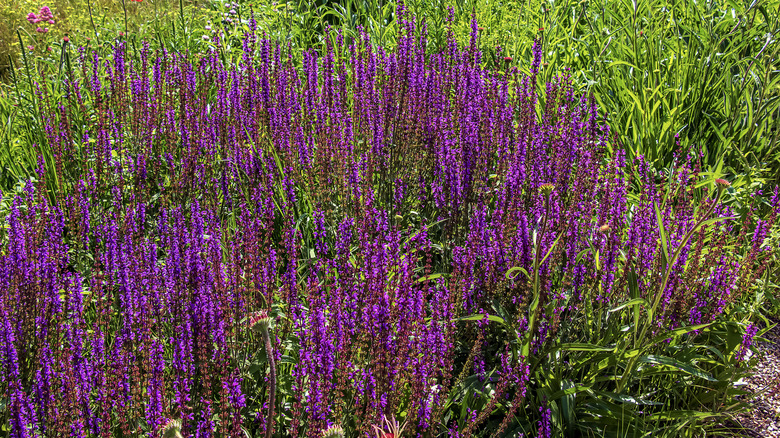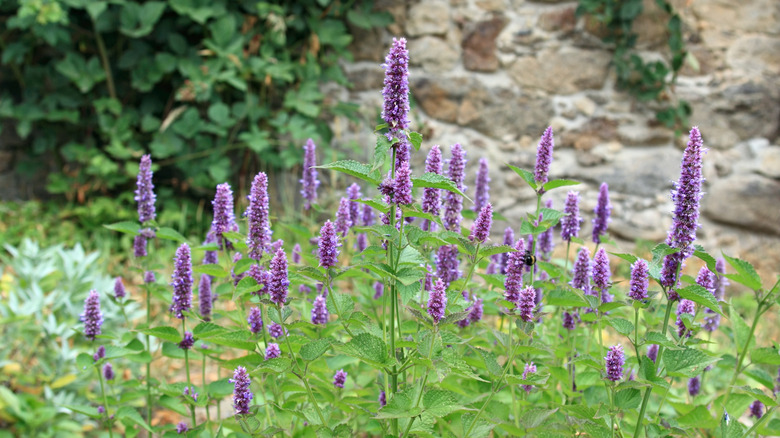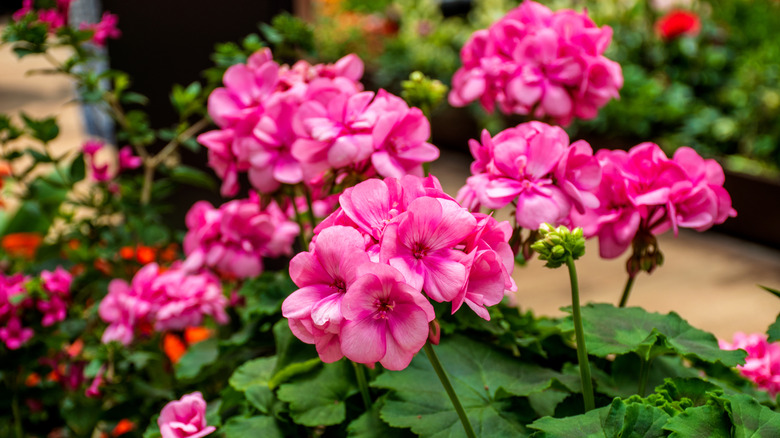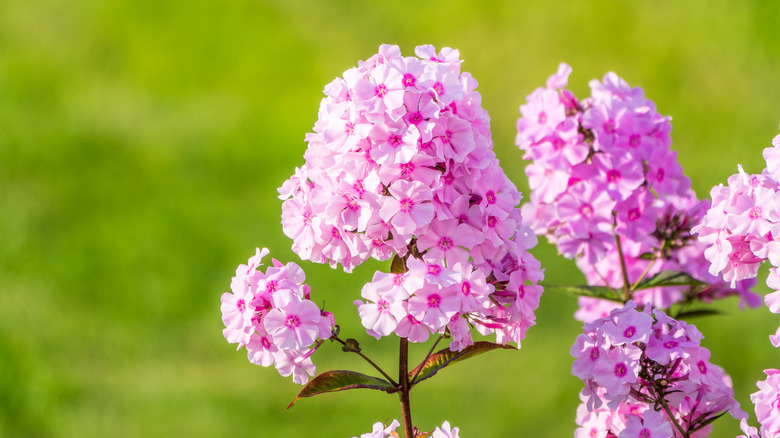Prune These 17 Perennials In Summer To Encourage More Showstopping Blooms Next Season
You've probably heard that you should think twice before pruning your garden in the summer heat. This is good advice, as several plants should not be cut back during the hot summer months since it can encourage new growth that is too tender to survive winter. However, there are some perennials that can benefit from summer pruning. Cutting these perennials back or deadheading them during the summer months can encourage additional blooms in the same season or ensure that they're in good shape to develop absolutely showstopping blooms next year.
Some of the perennials that you should start thinking about pruning over the summer include delphiniums, daisies, azaleas, and lantana. However, keep in mind that the specific timing and pruning needs of these plants can vary. Some should be pruned several times over the summer, while others should only be pruned once. Some should be pruned in the early summer, while others should be pruned towards the middle or end of it. Educate yourself so you'll know what to do and when you should do it in order to get the most beautiful blooms from your perennials.
Lupines
Lupines (Lupinus) are perennial flowers featuring a spiked shape and can grow to be up to 4 feet tall, producing purple, blue, white, pink, or yellow blooms. Lupines typically bloom between the end of spring and early July, depending on the variety. You can often get a second bloom if you prune in summer. After they've finished blooming, deadhead the flowers to encourage that second flush of blooms. Alternatively, cut off about half of the plant after the first bloom. Be sure to give it sufficient water to regrow, and you might be greeted with a glorious second bloom after several weeks.
Delphiniums
Pruning is one reason why delphiniums can be considered a higher-maintenance flower. However, when done correctly, you'll be rewarded with new blooms. After the flowers bloom for the first time, you should cut them back to the ground. Doing so will allow them to grow back and bloom one more time, either towards the end of the summer or the beginning of the fall. Additionally, you should also deadhead your delphiniums as individual flowers pass their peak bloom. This will allow new shoots to grow, creating an opening for new flowers to bloom next season.
Lavender
Pruning is essential for lavender's health, but don't make the mistake of pruning lavender at the wrong time of year. If not pruned, its stems will spread out too far and stop producing as many blooms. The ideal month to prune lavender will depend on the variety, but most plants will be ready in the summer. The key is to wait until after the first blooms have started fading. In addition to controlling the growth of the plant and encouraging blooms for the following year, pruning in the summer may also result in a second set of blooms for the current season.
Lantana
Summer is one of the best times to prune lantana plants. If these flowers are left to grow completely on their own, they can start to look rather scraggly before long. All of a sudden, your beautiful flower garden will look a bit rundown. To avoid this, you should stay on top of pruning throughout the summer months when the plant is growing quickly. Snipping away the tips of the flower stems will maintain the aesthetic appeal of your garden and encourage the flowers to produce additional blooms over the summer.
Catmint
Catmint is a fragrant lavender look-alike that can withstand harsher conditions. However, like lavender, it can also benefit from summer pruning. Cutting the plants back by about one-third to one-half after they have completed their first bloom can help ensure that you're greeted with a glorious second bloom later in the season. Unlike some other flowers, catmint may bloom twice without summer pruning. However, the blooms on stems that have been pruned will usually be much more pronounced and vibrant than those on the flowers that you did not prune.
Lady's mantle
Lady's mantle (Alchemilla) makes an attractive ground cover. When it blooms, it produces clusters of small, yellowish-green blooms. However, once the first blooms fade, the ground cover isn't as visually enticing. Fortunately, deadheading the flowers can encourage a second bloom, allowing you to enjoy the pretty blooms twice in the same season. After the first blooms have dropped, deadhead the flowers to allow new growth to occur. In addition to letting new blooms form, deadheading is also important to control the plant. If left alone, it will self-seed and potentially get unruly in your yard.
Azaleas
If you couldn't get enough of the vibrant blooms on your azalea bush this year, you can set yourself up for an even more stunning display next year. Azaleas can benefit greatly from a nice summer pruning. Cutting back the plant shortly after it's finished blooming can help increase how concentrated the flowers will be the following year. Just make sure that you don't wait until too late in the summer to prune your azalea bush, as this could actually prevent it from blooming as prolifically the following year, because the buds will be set by this point.
Yarrow
Establishing a summer pruning routine will help yarrow plants (Achillea) continue to produce vibrant flowers. When the blooms start dropping off, it is the perfect time to deadhead the flowers. Deadheading will not only help increase the chances for new blooms that season, but it will also help improve the overall look of your garden. You can also cut the plant back by about half its size to enjoy a repeat bloom later in spring.
Daisies
If you know how and when to deadhead daisies, then you'll be rewarded with new blooms that keep your garden more vibrant throughout the summer. Ideally, you should deadhead these flowers after the blooms have faded and started dropping. When this is done promptly, the chances for another round of blooms will be increased. Deadheading also prevents new seeds from forming and dropping into the soil. While new seeds might sound like a good idea, devoting resources to source production can mean there isn't enough energy left for the plant to grow an abundance of flowers.
Lemon balm
If you have lemon balm (Melissa officinalis) in your garden, add it to your summer pruning list. If you don't prune the plant over the summer, you may be threatening next year's growth. This is because the plants may grow too closely together, preventing sufficient air from flowing and keeping them healthy. So, after the lemon balm has flowered — and before it has had a chance to start producing seeds — cut about half of the height off of each of the plants. Be sure to give it sufficient water to help it recover and come back stronger.
Daylilies
Pruning your daylilies (Hemerocallis) can offer a variety of benefits. While some varieties will only produce a single bloom, others will offer a second flowering if you prune them after the first petals start dropping. Even for the varieties that won't give you a second round of flowers, deadheading the flowers during the summer will help ensure that your garden remains neat and tidy and doesn't look ragged or run-down. Just be careful not to cut the plants too often because daylilies can be vulnerable to overpruning, and they may not recover.
Bee balm
Bee balm (Monarda) is another perennial that can deliver a second round of gorgeous blooms if you deadhead the flowers as the first bloom is starting to fade. To deadhead beebalm, cut the flower head and stem back closer to the main stem to help new shoots form. For best results, check your plants once or twice a week to see which are ready to be deadheaded. In addition to deadheading throughout the summer months as the blooms fade, you should also consider giving a heavier-duty pruning to bee balm towards the end of the summer.
Salvias
Learn how to prune salvia and enjoy endless blooms all summer. This plant will reward you with new blooms when you deadhead those that are fading — just stay on top of deadheading it as each old flower begins dropping its petals. The type of salvia you have will also dictate other summer pruning tasks. Bedding salvias should have their tips pinched in summer to encourage a fuller plant. If you have herbaceous salvias, like Salvia nemorosa, you should cut the entire plant back after the first round of blooms have dropped — they'll grow back again and deliver more flowers weeks later.
Anise hyssop
While the main pruning for anise hyssop (Agastache foeniculum) should be completed during the spring, that doesn't mean that you should forget about these vibrant, spike-like flowering plants during the summer. If you keep up with deadheading the flowers during the early to mid-summer, then it will likely stimulate new growth and new, beautiful blooms. Avoid pruning anise hyssop towards the last half of the summer because you don't want the plant generating new growth as the weather turns colder in the fall. Otherwise, you're setting it up to potentially die over the winter.
Geraniums
Give your perennial geraniums some TLC during the summer months, and you'll reap the benefits of your hard work. Deadheading can encourage these plants to deliver new blooms later in the growing season, plus removing the flower heads before seeds are produced will ensure the plant's energy is directed towards new blooms. Depending on your location, geraniums may start dying back as early as August. If this occurs, it's time to prune the plant to only a few inches above the ground. Doing so will help ensure that the plant returns healthy — and with attractive blooms — next year.
Sunflowers
Pruning perennial sunflowers (Helianthus) is important during the summer. However, there are a few key things you should keep in mind to avoid making a mistake. First, it is critical to get your timing right, or you may interfere with their ability to deliver the gloriously large blooms you're awaiting. These flowers should be pruned in June to encourage the plants to fill out and prevent them from getting leggy. Avoid pruning sunflowers after they've started forming buds — typically towards the middle or end of summer. However, once those buds have bloomed, you can deadhead them to encourage reblooming.
Phlox
There are several varieties of phlox that can benefit from deadheading. Removing the old blooms will open the door for new ones to grow. However, the other pruning needs of phlox will vary depending on which variety is in your yard. Creeping phlox can benefit from a summer pruning, as it blooms earlier than its taller counterpart — all of the blooms will have dropped by early summer. At this point, you can help enhance the plant's shape by cutting it back by about one-third of its height.
